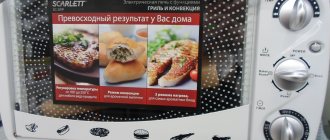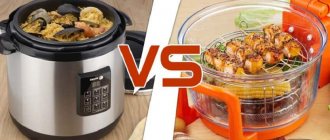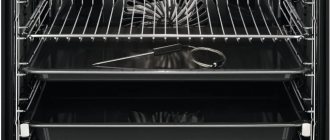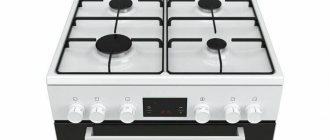Microwave oven and mini-oven: what is common and what is the difference
Housewives have known the microwave for many years, but the mini-oven appeared on the household appliances market not so long ago. The mini-oven performs the functions of an oven, toaster, grill and microwave, as it is capable of defrosting food and heating food.
Similarities
The devices are similar in appearance. On the front side there is a glazed door and a control panel. They are compact and fit on the kitchen counter due to their small dimensions - within 30x50x40 cm. The size of the internal chamber is from 10 to 40 liters. The microwave and mini-oven (or electric oven is its second name) operate from the mains.
There is a similarity in electricity consumption: for a mini-oven it is 1.5-2 kV, for a microwave oven it is from 1 to 2 kV. These figures refer to devices with similar standard functionality and a price in the range of 5,000-10,000 rubles. As the chamber volume increases and additional functions are available, the energy consumption of the devices increases.
The type of furnace control can be mechanical or electronic. The advantage of a mechanical one is its simplicity and reliability, and an electronic one is an expanded choice of cooking methods.
The internal coating of the microwave and mini-oven chambers is made of enamel, stainless steel or ceramics. It is important that it can withstand high temperatures and is easy to clean.
Both devices are equipped with an internal chamber light, a tray for collecting crumbs and fat (in a microwave, this function is performed by a rotating plate), and a timer.
More expensive models of mini-ovens and microwaves have additional modes: convection, grill, spit. The energy consumption and price of such devices are significantly higher.
Differences
How is a microwave oven different from an electric oven? The main difference lies in the principle of operation. A mini-oven, like a traditional electric oven, cooks food using the heat generated by thermal heating elements - heating elements. The oven can reach temperatures from 30 to 250°C, baking the dish evenly.
A microwave oven cooks using ultra-high frequency (microwave) radiation, which is generated by a magnetron. Under the influence of microwaves, the water molecules present in any food begin to move, as a result of which the water boils, and the food in which it is contained rapidly heats up. Heating does not occur gradually and not from the outside in, as happens in a conventional oven, but throughout the entire product at once. In this case, the temperature does not rise above the boiling point - 100°C.
In most cases, a microwave oven is used to heat and defrost food. The main purpose of a mini-oven is cooking.
Microwave Oven Features
The main advantage of a microwave is its speed. 1-2 minutes is enough to heat up the finished dish. The plate will remain cool, and if it warms up, it will only be due to the temperature of the food itself. In the microwave you can cook oatmeal, quickly bake vegetables, and prepare some other simple dishes. The porridge will be cooked in a deep bowl in 2-3 minutes, and the omelette will be baked in a plate in 5 minutes. Using a microwave reduces the time for cooking and heating food and, as a result, energy costs.
But this device also has a significant disadvantage. Cooking in a microwave oven occurs on the principle of internal heating and evaporation - this limits the possible range of dishes. In a budget microwave, the meat will not turn crispy, and you will also not be able to bake a pie.
More complex devices are designed for frying and baking - combination microwave ovens, equipped with additional functions.
Reference. The following manufacturers offer high-quality microwave ovens: Samsung, Gorenje, LG, Hotpoint-Ariston, Redmond, Daewoo, Supra, BBK.
Varieties
Based on the operating principle of microwave ovens, they can be divided into several groups:
- Microwave, operating due to microwave radiation. Most often used for defrosting and heating ready meals. These models are the most popular and enjoy the most consistent consumer demand.
- A microwave oven with grill is a combined device, additionally equipped with heat emitters (quartz lamps or tubular heating elements). Microwave with grill is aimed at a more complex menu. You can fry meat with a golden brown crust, fish, and French fries in it.
- Convection microwaves . In such ovens, streams of hot air, pumped using special fans, are directed at the dish being prepared. Circulation of hot air promotes uniform baking of the product. If in a simple microwave the temperature does not rise above 100°C, then in an oven with convection mode it can reach up to 250°C. Such a microwave oven can replace an oven. Models with a convection function are much more expensive than a conventional microwave, their dimensions are larger, and their energy consumption is significantly higher.
- Inverter microwave. Microwave of the latest generation. The peculiarity of this device is that the radiation from its magnetron is controlled electronically. In a conventional microwave, the magnetron operates with constant power; its periodic turning off and turning on leads to a harsh effect of the emitter on food and surges in electricity in the network. Inverter ovens are more economical, but what is more important is that in them microwaves have a gentler effect on the product being processed.
- Multifunctional microwave ovens. The most expensive microwaves with grill and convection have various built-in programs, for example, defrosting followed by cooking, remember frequently used recipes, and can be programmed to prepare dishes according to their own “branded” recipes. The price of such stoves is from 20,000 to 40,000 rubles.
Advantages
Advantages of a microwave oven:
- high speed of cooking and heating food;
- the ability to cook without adding oil and fat, which is important for adherents of a healthy diet;
- preservation of vitamins and microelements, since food is heated quickly and is limited to 100°C;
- absence of food odors, which is important when using a microwave, for example, in the office;
- the ability to heat food directly in the plate, which is convenient and saves effort and time on washing dishes;
- compact size and nice design, the ability to be built into kitchen furniture or mounted on a bracket, which is important in small spaces.
Flaws
Microwave radiation. There is no objective data proving that microwaves are harmful to human health. However, an increasing number of people are refusing to purchase this device in favor of more environmentally friendly devices. And some people simply don’t like the taste of dishes cooked in a microwave oven; they consider it “artificial.”
When using a microwave, the following precautions should be taken:
- Do not use metal utensils or utensils coated with metal.
- When using plastic utensils, you should be guided by the “microwave” marking or the three-wave icon.
- You cannot heat liquids in closed containers, boil eggs, and peeled vegetables and sausages must first be pierced.
- It is forbidden to turn on an empty microwave.
- You should heat the water with caution, because if it overheats, it can boil almost instantly even from careless movement.
Features of the mini oven
In a mini-oven you can bake cakes, pies and cookies, bake meat and fish, and stew vegetables. That is, cook the same dishes as in a conventional oven, only faster and more economically.
The volume of a standard oven is 50-70 liters, power consumption ranges from 2.5-4 kW, and the heating time to 180°C is 10-15 minutes. To maintain the desired temperature during baking, a sufficient amount of energy is required. Everyday meals are usually small and disproportionate to the volume of the chamber. It turns out that most of the oven's energy is wasted irrationally.
Due to its small volume, a mini-oven can heat up faster and maintain a high temperature longer. For example, a stove with quartz heaters reaches a temperature of 200°C in 2-3 minutes.
The advantage of a mini oven is that its performance is comparable to a full-size oven, and its energy consumption is lower.
The larger the volume of the oven, the more power is required to heat it up. The most popular models are those with a power of 1000-1500 kW.
Reference. Mini-ovens from the following manufacturers are popular: Bork, Delonghi, Simfer, Kitfort, Rommelsbacher, Dex, Galaxy, Steba, Gemlux, GFgril Breakfast Bar.
Modes
In a mini-oven, food is cooked under the influence of heat emitted by heating elements located in the upper and lower parts of the chamber. In a number of models, heating elements are replaced with quartz lamps. Such ovens heat up to the desired temperature faster.
The standard operating mode involves top or bottom heating or simultaneous heating of two elements. Additional modes: cooking pizza, single-sided or double-sided toast, baking, reheating, quick heating, defrosting and others.
Some models are equipped with convection and grill functions. Most ovens have a spit, a metal pin on which vegetables or meat are placed.
Regardless of size, all mini-ovens operate the same way - bake and stew. The only difference is the number of servings. A compact electric oven can fully satisfy the needs of an average family of 3-5 people.
Advantages
A mini-oven can replace a whole range of kitchen appliances and has many advantages:
- small size - suitable for a small kitchen, cottage, rented apartment, dormitory;
- the small volume of the chamber heats up faster and retains heat longer compared to a stationary oven;
- traditional, natural way of cooking, in which everything is delicious;
- the ability to quickly heat up dishes with a crispy crust;
- ease of use;
- an impressive list of dishes to prepare;
- profitability - low price and lower energy consumption compared to an oven;
- possibility of cooking in almost any container: metal, ceramics, clay, silicone, fireproof glass.
Flaws
With all its undeniable advantages, a mini-oven is a smaller and simplified oven model. Its two main advantages - its small size and a full range of oven functions - led to the presence of some disadvantages.
The body of the electric furnace heats up, and you can get burned on the walls and glass.
The tempered glass of the door (single in budget models, double in more expensive ones) also heats up. For comparison, the door of a stationary oven has four layers of protective glass.
Attention! If there are small children in the house, you need to make sure that they do not approach or touch the appliance while the mini-oven is operating.
Mini-oven - necessary, useful and useless functions
A mini oven is a device that allows you not only to heat food, but also to defrost, cook and even use it as a grill.The range of functions of a mini-oven depends on the model and volume. The oven volume can be a minimum of 12 liters and a maximum of 40 liters. As for the functions, it is believed that it is best to buy a stove with a minimum set of functions, that is, only for cooking. Accordingly, all other functions should be related to this main task. In this case, the mini-oven will effectively cope with its task.
Many ovens are equipped with a grill. It is difficult to say whether this function is useful or not. It all depends on the needs of the owners. But for lovers of crispy crust, this function will be quite useful.
The convection function evenly distributes hot air over the surface, which makes it possible to bake pies. But the baked goods still don’t turn out as tasty and well-baked as in a regular oven. Therefore, it is safe to say that this feature is optional. No, if the kitchen does not have an oven, then this function is very important.
The time sensor allows you to set the heating time. The sound signal allows you to calmly go and do your business, and not have to watch when the food stops cooking. A sound will notify you that heating has stopped.
The number of grates, the presence of a frying dish and other utensils are important only when the mini-oven will be used not only for heating, but also for cooking.
If there are small children in the house, a child lock is an indispensable feature. In this case, children will not be able to open doors or press any buttons on their own.
Before you understand which functions are useful and which are not, you need to know exactly why you are buying a mini-oven and only then draw conclusions about the availability of functions. Of course, it is most suitable for those who do not have the opportunity to install an oven in their small kitchen.
How to choose a mini oven
You have decided to buy a mini-oven, but you are not fully aware of how to do it. Then in this article, the online publication “My Choice” talks about how to choose the right mini-oven, as well as which oven is better to choose.
First, it is necessary to clearly understand that a mini-oven is not a microwave. The mini oven allows you to use it as a grill, toaster and oven. It is perfect for a small family and a small kitchen; it helps the main oven cook a large amount of food.
When choosing a mini-oven, the first thing you should pay attention to is the volume. The oven volume varies from 8.5 to 40 liters. However, it does not affect the set of functions. Even the smallest mini-oven can have a full set of all necessary functions. For an average family, a mini-oven with a volume of 12.5 to 28 liters will be sufficient.
If you are a pie lover, then in this case you should pay attention to a larger oven. It is believed that the larger the oven volume, the tastier the pies will be. But you shouldn’t immediately rush out and buy a 40-liter mini-oven, especially when your family consists of 2 people. There is no need for this.
The second thing you should pay attention to is the inner coating of the oven. A high-quality coating on a mini-oven is always easy to identify. In this case, the instructions will be marked “Durastone”, which means resistance to scratches, high temperatures and chemicals. The higher the quality of the coating, the longer the mini-oven will last and the easier it is to care for.
When choosing a mini-oven, you should pay attention to such a function as convection. This function evenly heats the air over the entire area of the device, and the food is evenly cooked. A fan is used for the convection function. In some models, it can simultaneously operate in two different modes and cook two different dishes at the same time. Studies have shown that using this feature reduces cooking time by 20 to 50 percent.
If your kitchen already has a traditional oven, then you can consider models without a convection function, but with two heating elements located at the top and bottom. Such models have four operating modes.
The defrosting function will be useful only if there is no microwave in the kitchen, but you need to quickly defrost food. Mini ovens have several defrosting modes.
Please note that there is a timer in the mini-oven. The timer allows you to program the cooking time and not worry that your food will burn or be raw. The presence of a sound signal notifies you when the dish is ready. Today, almost all models have a timer, but not all have the ability to set a control time, which means that many dishes can be cooked automatically and be half-baked.
Make the right choice and enjoy the food you prepare.
Internet publication “My Choice”
Can an electric oven be used as a microwave?
More and more people, fearing the negative effects of microwaves, are looking for a replacement microwave oven.
A mini-oven, like a microwave, can be used to heat and defrost food. Defrosting in an electric oven occurs almost naturally under the influence of low temperatures (30-40°C), as if the product was simply placed in a warm place.
When heating ready-made dishes in an electric oven, the product is evenly heated from below, above and on the sides. Overdrying of food, which is typical for heating in the microwave, is excluded. You can make a hot sandwich in minutes. It’s more difficult with liquids: you can’t heat up the soup and serve it on the table in the same bowl. You also won't be able to warm up a mug of cold milk without heating the pan.
Myths about the microwave. There is an opinion that microwaves can change the structure of water and food and turn beneficial substances into carcinogens. However, microwave energy is not enough to break chemical bonds. In addition, it is known that water (except for frozen water) does not have a constant structure.
What is better: microwave or electric oven?
If you have a choice between a microwave and an electric oven, then you must decide why you are purchasing it. What are you planning: reheat, defrost or bake some delicious dish. By answering this question and understanding the operating principle of kitchen appliances, you can find out which is better: a microwave or an electric oven?
What can microwaves do?
First, let's figure out how a microwave oven works. It functions thanks to a magnetron. This device converts electrical energy into a powerful ultra-high frequency electromagnetic field, which affects water molecules found in products. They, in turn, vibrate and release thermal energy, which heats the food. In this case, rapid evaporation of moisture from the food occurs, which leads to the effect of drying out the food. Therefore, many manufacturers recommend heating food under the lid.
When purchasing a microwave, you should prepare special dishes that can be used for cooking in it. Plates and pots should not have metal parts or designs.
Newer models are additionally equipped with forced convection for uniform temperature distribution throughout the entire body of the device. This promotes better baking of products. Infrared radiation sources are also installed in microwave ovens for grilling food. It is possible to use combined cooking modes for different culinary delights. This increases the range of dishes that can be cooked in the microwave.
Now let's talk about the dangers of microwaves. They actually work using an electromagnetic field, which negatively affects human health. To reduce it, manufacturers install reliable shielded protection on microwave ovens. Therefore, in good condition, the devices are completely safe to use. However, destruction of the protective screen may occur, and it is quite difficult to detect this on your own.
What to expect from infrared radiation?
How does an electric furnace work? Its operation is carried out using infrared radiation sources called electric heaters. Hence the conclusion that there will be no electromagnetic radiation. Infrared waves heat up anything that absorbs them. Thanks to this feature, you can count on uniform heating of all products placed in the device.
Manufacturers allow any heat-resistant utensils, including metal ones, to be placed in an electric oven. The evaporation of moisture from food during cooking in it is not so intense, which makes baking without a lid possible.
In terms of their dimensions, both kitchen appliances are comparable to each other. But the microwave is heavier due to its magnetron. In practice, they are most often used for heating and defrosting food. And electric ovens for roasting and baking. Based on the main capabilities of the devices, make your final choice.











